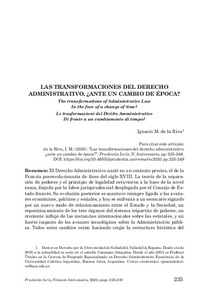Please use this identifier to cite or link to this item:
https://repositorio.uca.edu.ar/handle/123456789/10758| Título: | Las transformaciones del Derecho Administrativo ¿ante un cambio de época? The transformations of Administrative Law : in the face of a change of time? Le trasformazioni del Diritto Amministrativo : di fronte a un cambiamento di tempo? |
Autor: | Riva, Ignacio M. de la | Palabras clave: | DERECHO ADMINISTRATIVO; PRINCIPIO DE SUBSIDIARIEDAD; PRINCIPIO DE LEGALIDAD; ADMINISTRACION PUBLICA | Fecha de publicación: | 2020 | Editorial: | Universidad Católica Argentina. Facultad de Derecho | Cita: | de la Riva, I. M. Las transformaciones del Derecho Administrativo ¿ante un cambio de época? [en línea], Prudentia Iuris. 2020, nro. aniversario. Disponible en: https://repositorio.uca.edu.ar/handle/123456789/10758 | Resumen: | Resumen: El Derecho Administrativo nació en un contexto preciso, el de la
Francia posrevolucionaria de fines del siglo XVIII. La teoría de la separación
de poderes y el principio de legalidad estuvieron a la base de la novel
rama, forjada por la labor jurisprudencial desplegada por el Consejo de Estado
francés. Su evolución posterior se mantuvo siempre ligada a los avatares
económicos, políticos y sociales, y hoy se enfrenta a un escenario signado
por un nuevo modo de relacionamiento entre el Estado y la Sociedad, un
reposicionamiento de los tres órganos del sistema tripartito de poderes, un
creciente influjo de las instancias internacionales sobre las estatales, y un
fuerte impacto de los avances tecnológicos sobre la Administración pública.
Todos estos cambios están haciendo crujir la estructura histórica del Derecho Administrativo, y obligan a repensar el alcance de sus categorías
clásicas con vistas a aggiornarlas al presente statu quo. Abstract: Administrative Law was born in a precise context, that of postrevolutionary France at the end of the 18th century. The theory of the separation of powers and the principle of legality were at the base of the new branch, forged by the jurisprudential work carried out by the French Council of State. Its subsequent evolution was always linked to economic, political and social vicissitudes, and today it faces a scenario marked by a new way of relating between the State and Society, a repositioning of the three organs of the tripartite system of powers, a growing influence of international instances on state ones, and a strong impact on public administration of technological advances. All these changes are making the historical structure of Administrative Law crunch, and they force us to rethink the scope of its classic categories with a view to adjust them to the present status quo. Sommario: Il Diritto amministrativo nacque in un preciso contesto, quello della Francia post-rivoluzionaria alla fine del XVIII secolo. La teoria della separazione dei poteri e il principio di legalità erano alla base del nuovo ramo, forgiato dal lavoro giurisprudenziale svolto dal Consiglio di Stato francese. La sua successiva evoluzione fu sempre legata alle vicissitudini economiche, politiche e sociali, e oggi affronta uno scenario segnato da un nuovo modo di relazionarsi tra Stato e Società, un riposizionamento dei tre organi del sistema tripartito di poteri, una crescente influenza degli enti internazionali sullo stato, e un forte impatto dei progressi tecnologici sulla pubblica amministrazione. Tutti questi cambiamenti stanno causando il crollo della struttura storica del Diritto amministrativo e ci stanno costringendo a ripensare le sue categorie classiche al fine di adattarli allo status quo attuale. |
URI: | https://repositorio.uca.edu.ar/handle/123456789/10758 | ISSN: | 0326-2774 2524-9525 (en línea) |
Disciplina: | DERECHO | DOI: | https://doi.org/10.46553/prudentia.aniversario.2020.pp.235-249 | Derechos: | Acceso abierto | Fuente: | Prudentia Iuris 2020, Número Aniversario |
| Appears in Collections: | PI - 2020 nro. Especial 40º aniversario |
Files in This Item:
| File | Description | Size | Format | |
|---|---|---|---|---|
| transformaciones-derecho-administrativo.pdf | 98,35 kB | Adobe PDF |  View/Open |
Page view(s)
457
checked on Apr 27, 2024
Download(s)
1,286
checked on Apr 27, 2024
Google ScholarTM
Check
Altmetric
Altmetric
This item is licensed under a Creative Commons License

